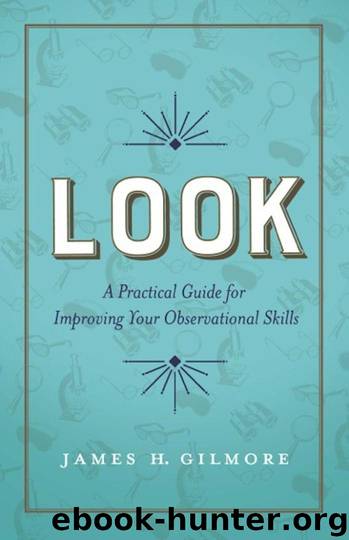Look: A Practical Guide for Improving Your Observational Skills by James H. Gilmore

Author:James H. Gilmore
Language: eng
Format: azw3, epub, mobi
ISBN: 9781626343009
Publisher: Greenleaf Book Group Press
Published: 2016-08-22T23:00:00+00:00
26
CHECKING FOR MORE DETAILS
Of course you can become easily exhausted from excessive microscope looking. It can simply become too intense. But microscope looking need not examine “each and every detail”—in an absolute sense—in each and every circumstance. The key is to take time to look for more details, not necessarily all details. Microscope looking simply notices what would not normally be noticed without it. There may be some situations in which the microscope looking continues until you find a specific noteworthy detail (such as finding the error in an unbalanced checkbook). Or you could simply stop (or take a break) when you can no longer maintain the sustained attention.
There are some circumstances, however, that require a completely exhaustive examination. Consider a pilot and copilot performing their preflight inspection of the plane’s controls and operating systems. As passengers, we want all the details scrutinized and studied via in-depth microscope looking (and not with a cursory scan). Of course, pilots work off a checklist to examine these details. But consider this: Any comprehensive checklist is the result of someone doing prior microscope looking. The very purpose of any checklist is to codify microscope looking. (For example, if I had a checklist for paying bills I probably would have caught my ten-dollar mistake before it occurred.)
Most observations, however, are not made via checklists. At any given moment, you may be called upon to examine the details of a particular situation. Such times seldom afford the luxury of moving through items on a predetermined checklist. Without such a list, you must discover what items ought to be explored in greater detail. In most circumstances, no one could have anticipated the looking required for the particular moment. The looking becomes the checking, and the checking is the in-the-moment uncovering of discoveries made while looking.
Microscope looking is looking with a “fine tooth comb.” It doesn’t look at the big picture, the overall scene (in which most details, by definition, are not seen). It looks at one little picture after another little picture after another—seeing what cannot be seen without such granular gazing.
Recall the scene from the classic film E.T. the Extraterrestrial when E.T. hid in the closet among all the plush-toy creatures. Elliott’s mother opens the door and sees a closet full of stuffed animals—the “big picture.” Had she done some microscope looking—scrutinizing and studying each creature one by one—she would have noticed the one poker-faced alien unlike the others. As viewers of the movie, we see E.T., because film producer Steven Spielberg has the camera slowly pan across the closet contents. This panning serves as a form of microscope looking for his audience. Spielberg’s camera becomes our microscopic lens. Had the camera not panned as it did, viewers would likely have missed seeing E.T., too.
Microscope looking often uncovers that which was not spotted using magnifying-glass looking. What magnifying-glass looking cannot pinpoint, microscope looking may find when it pans for more details.
You can use microscope looking after magnifying-glass looking, especially if the magnifying glass fails to spot something significant.
Download
Look: A Practical Guide for Improving Your Observational Skills by James H. Gilmore.epub
Look: A Practical Guide for Improving Your Observational Skills by James H. Gilmore.mobi
This site does not store any files on its server. We only index and link to content provided by other sites. Please contact the content providers to delete copyright contents if any and email us, we'll remove relevant links or contents immediately.
Nudge - Improving Decisions about Health, Wealth, and Happiness by Thaler Sunstein(7656)
Deep Work by Cal Newport(6966)
Principles: Life and Work by Ray Dalio(6296)
The Doodle Revolution by Sunni Brown(4713)
Factfulness: Ten Reasons We're Wrong About the World – and Why Things Are Better Than You Think by Hans Rosling(4713)
Eat That Frog! by Brian Tracy(4483)
Thinking in Bets by Annie Duke(4184)
Hyperfocus by Chris Bailey(4086)
Visual Intelligence by Amy E. Herman(3752)
Writing Your Dissertation in Fifteen Minutes a Day by Joan Bolker(3696)
Ogilvy on Advertising by David Ogilvy(3552)
How to Win Friends and Influence People in the Digital Age by Dale Carnegie & Associates(3518)
Hidden Persuasion: 33 psychological influence techniques in advertising by Marc Andrews & Matthijs van Leeuwen & Rick van Baaren(3517)
How to win friends and influence people by Dale Carnegie(3437)
The Pixar Touch by David A. Price(3389)
Schaum's Quick Guide to Writing Great Short Stories by Margaret Lucke(3343)
Deep Work: Rules for Focused Success in a Distracted World by Cal Newport(3182)
Work Clean by Dan Charnas(3080)
The Slow Fix: Solve Problems, Work Smarter, and Live Better In a World Addicted to Speed by Carl Honore(2975)
